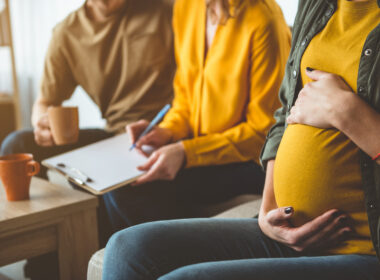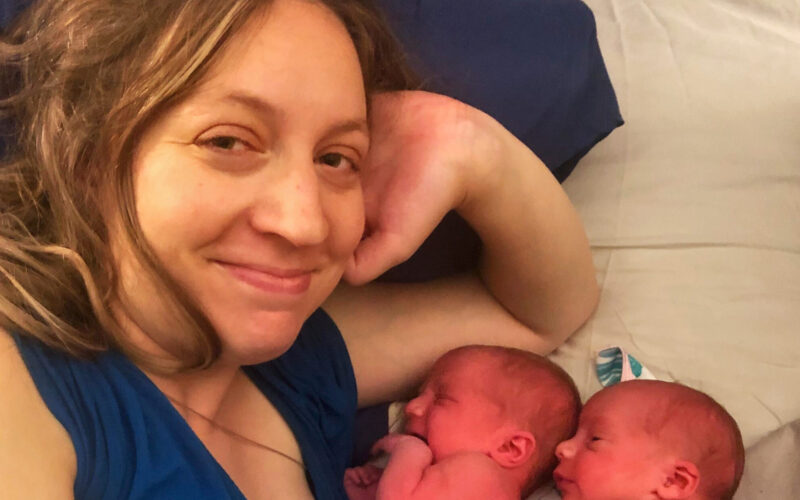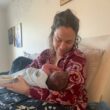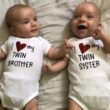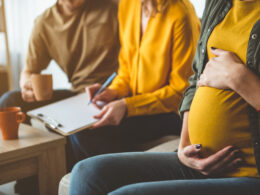“I need you to get out of the water.”
I looked up at my midwife as I cradled one fresh, wrinkled wet baby on my stomach above where the other one still lay hidden. I couldn’t pull my daughter any higher up on my body because her umbilical cord was so short.
“I can’t monitor your bleeding while you are in the tub. Can you come out of the water onto the bed?”
That’s how I found myself, holding one twin outside of the womb while carrying the other twin inside, feeling deflated from birth, trying to stretch my short legs over the wall of the birth tub while dodging my baby’s umbilical cord (still attached). Like many other times during my pregnancy, I found myself wondering, “How in the world did I get here?”
Here’s how.
Learning I was expecting twins
Like many other women who chart using a fertility awareness-based method, I found out I was pregnant about as soon as I could pee on the stick. Unfortunately, my pregnancy sickness also began around the same time, which was earlier than usual for me (this was my third pregnancy). I felt sicker than I ever had before, and threw up a few times with very strong food aversions, which again was unusual for me. I chalked it up to increased fatigue from having two young kids to chase after this time around, and scheduled the routine 8-week ultrasound at the local pregnancy center.
As soon as the tech pressed the wand on my belly, she said, “Do you see what I see?”
“No…” my husband and I answered with trepidation.
“There’s two!” she cried, excitedly shifting the view so we could clearly see that, indeed, two little jelly beans wiggled gently on the screen in front of us. I started laughing, and my husband was flabbergasted, which I suppose sums up our collective reactions ever since. It just seemed so silly that we would be a twin mom and dad!
Encountering cultural assumptions about twin birth
Of course, our brains were immediately whirling and just as fast came the questions from other people:
“Are they identical?”
“Do they share the same sac?”
“Is there one placenta? Or two?”
“Do twins run in your family?”
“Where are you going to give birth?”
“How far are they going to let you go?”
“Don’t twins come early?”
“Are you going to be induced?”
“Are you going to have a C-section?”
The more I spoke to those around me, the more I realized several underlying cultural assumptions about twins. #1: Having twins is inherently high risk. #2: Twins always come early. #3: The twins would probably be born by C-section, because even if my doctor “let” me try a vaginal birth, one of the babies would likely be breech (and very few OB-GYNs are trained in delivering breech). #4: My babies would require time in the NICU for being premature. #5: Breastfeeding would be difficult or even impossible, with formula becoming necessary to supplement.
I learned to be cautious about who I revealed my birth plan to, as my desire for a home birth was often met with aghast faces believing me to be some kind of adrenaline junkie. In the experience of many (if not most) twin moms I know, birth—which is already often over-medicalized—is even more so when two babies are present instead of one.
In the experience of many (if not most) twin moms I know, birth—which is already often over-medicalized—is even more so when two babies are present instead of one.
My twin pregnancy wasn’t risk-free
That isn’t to say my pregnancy was without some risks. When I was about 2 ½ months pregnant, I had very sudden, gushing bleeding. It was Christmas Eve. We had just returned to my mom’s house after having a celebration with my extended family, and I felt the gush as I pulled on my cozy pajamas. Of course, I thought I was having a miscarriage. I am so grateful I was under the care of a midwife because she was very accessible, even on Christmas Eve, and we were able to speak with her over the phone right away.
She advised immediate bedrest, with cups of cinnamon tea to help stave off the bleeding*, and ordered topical progesterone cream for me to apply vaginally. I remember gulping down the hot water with ground cinnamon in bed on Christmas morning while hearing my children open up presents in the next room over, trying not to lose hope while also bracing myself for loss. (*For more on the surprising uses of cinnamon, including evidence that it may alleviate heavy menstrual bleeding, see this article en Naturaleza.)
Amazingly, and perhaps because we were able to address things so quickly with my midwife, the bleeding stopped. A follow-up ultrasound when we returned to our home revealed two healthy babies y no diagnosable issues. (Interestingly, after I birthed the placenta, there was a large “scab” on one side of the organ that my midwife thought might have been the cause of the bleeding.)
The possibility of postpartum hemorrhage
We also had to address postpartum hemorrhage risk. Years ago, when I was first married, I was diagnosed with a heart condition called atrioventricular heart block (AV block). I only happened to receive this diagnosis because I had gone to the ER with a bad stomach bug and my heart rate was low. After being hospitalized, undergoing other tests, and meeting with various cardiologists, I learned I’ve always had this condition but never had symptoms. I can live my life normally, just like anyone else, so long as no symptoms like shortness of breath, palpitations, dizziness, etc. appear.
I had already given birth twice with this condition (once in the hospital and once at home), so when it came to considering home birth with twins, I didn’t think twice about the heart block. But we discovered late in the pregnancy that if I were to start hemorrhaging after birth, my heart could go into failure. I had never had issues with post-birth bleeding before, but having twins threw things up in the air a bit. What if the placenta started to separate before Baby B was born? What if my heart had difficulty dealing with the extra blood and fluid volume?
Deciding between hospital or a twin home birth
On one hand was giving birth in a hospital. The benefit was immediate help in case of postpartum hemorrhaging, which was possible but not probable. The risks were an environment where I was not comfortable, the likelihood of being pushed to receive interventions, and a good chance that it would all end in C-section anyway, because if one baby happened to flip breech at the last minute, no local doctor would know how to assist.
On the other hand, I could stick with my vision of a twin home birth, and be able to give birth in my own space, surrounded by people I trusted, and in the water (which I knew from experience was much more relaxing and would help prevent major tearing). I would be in the hands of a highly skilled midwife who was trained in breech delivery and had assisted in many twin births. Yes, I might be risking heart trouble if I were to bleed out too much after birth, but major surgery (such as a C-section) could strain my heart as well. Why would I assume that a Cesarean is the safer option, given this reality and the other risks associated with it?
Yes, I might be risking heart trouble if I were to bleed out too much after birth, but major surgery (such as a C-section) could strain my heart as well.
Fortunately, I had the backing of my cardiologist, my family doctor, and the doctor with whom my midwife was consulting, who not only specialized in high-risk births but also taught other providers how to deliver breech babies safely. In fact, this last doctor opined to my midwife that I would be safer with a twin home birth than in a hospital simply because of the one-on-one care I would receive from her.
My twins weren’t born early
My in-laws, who we had asked to stay with us for a while to help out prior to the birth and during it, came a whole month early because they expected our twins to come early. The question “Has she had the babies yet?” became more annoying than the pregnancy itself. And yet, this is the cultural expectation.
Según “Help! I’m Having Twins”, the range of average gestational age for twins is 28 to 40 weeks, compared to 35 to 42 weeks for singletons. There are a host of reasons twins may be born early, including complications with the babies or with the mom.
After my bleeding incident early on, my midwife told me I should be eating 120 grams of protein daily to keep up with nourishing both my babies and myself! I stuck to this regimen very faithfully, as adequate protein can help prevent many complications, including gestational diabetes, preterm birth, low birth weight, and preeclampsia, to name a few. And I do think, in my case, it did wonders for the health of both me and my twins.
In Part II, you’ll read the rest of my twin homebirth story.

